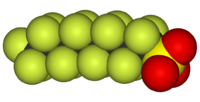
Photo from wikipedia
Abstract A parametric shrinking-core model is used to quantify the dechlorination rate of chlorinated pollutants dissolved in water by zero-valent iron nanoparticles (nZVI). The mass-transfer processes are coupled with the… Click to show full abstract
Abstract A parametric shrinking-core model is used to quantify the dechlorination rate of chlorinated pollutants dissolved in water by zero-valent iron nanoparticles (nZVI). The mass-transfer processes are coupled with the instantaneous reaction occurring in the solid/liquid interface to compute the transient changes of dissolved pollutant concentration in bulk and suspended nZVI concentration. A sensitivity analysis is carried out to identify the dominant parameters governing the overall reaction rate for a system of uniform nanoparticles. The model is extended to assemblages of non-uniform ZVI nanoparticles with sizes following a distribution function. The statistical shrinking-core model is used to estimate the PCE dechlorination kinetic parameters along with the mass-transfer coefficients with inverse modeling of batch experiments. The observed discrepancy between numerical predictions and experimental datasets may be attributed to uncertainties associated with the nZVI oxidation by other species, and PCE adsorbed on oxidized iron. An approximate analysis of model equations allows the development of an analytic phenomenological model providing the overall reaction rate as a function of dissolved PCE concentration.
Journal Title: Chemical Engineering Science
Year Published: 2017
Link to full text (if available)
Share on Social Media: Sign Up to like & get
recommendations!